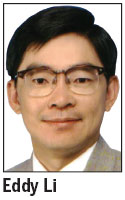Suggestions to authorities after my first visit to prison
Updated: 2013-03-14 06:10
By Eddy Li(HK Edition)
|
|||||||||
In Hong Kong, the historical functions of Justices of the Peace have been replaced by full-time, legally qualified magistrates. Nowadays, Justices of the Peace are essentially titles of honor given by the government to community leaders, and to certain officials while in their terms of offices. They have no judicial functions, and their main duties include visiting prisons, institutions for young offenders and drug addicts, psychiatric hospitals, remand homes, places of refuge, reception and detention centers, administering statutory declarations, and serving as members of advisory panels.
Days ago, as a Justice of the Peace, I, for the first time, carried out my duty of visiting a prison under the arrangement of authorities. We arrived, by helicopter, at Shek Pik Prison in Lantau Island. Although I have been to many places and attended numerous activities and functions, this was my inaugural visit to a prison - a maximum security institution - so I was enlightened and impressed by this visit.
Taking off the life jacket, stepping down from the helicopter, and guided by officers from the Correctional Services, I began my inspection tour in this so-called "land of secret" in the public's eyes. Although being a maximum security institution, the prison does not give the impression of being strongly fortified; instead, the general environment is quite comfortable.

The Correctional Services officers informed me there are now more than 390 prisoners in Shek Pik, which are divided into three designated levels - A, B and C. Prisoners are kept in captivity and assigned with officers according to their levels. Other than police, there are also doctors, dieticians, psychiatrists and factory supervisors - the prisoners are "pretty well looked after".
With a rigorous regulatory regime, the prison adopts a 24-hour duty procedure, in which there are four work shifts rather than three in one day, to guarantee that there is sufficient manpower and that the physical and mental condition of officers is appropriately alert to deal with emergencies.
As for the daily necessities given to the prisoners, the authorities have specially selected a series of items which ensure they will not be used to attack, self-mutilate or even become suicidal weapons.
In recent years, there have been few, if any, serious complaints from the prisoners. I believe this is the result of continuous efforts made by Correctional Services in their management, all indicative of the "humanity and civilization" of the Hong Kong SAR government.
However, after this visit, I was also made aware of the substantial resources the government has committed to correctional work. Take the Shek Pik Prison for example; overall there are more than 300 staff working in different positions - almost as many as the number of its prisoners. In other words, with each new prisoner added to Hong Kong's prisons, the HKSAR government will have to bear the expense of a prisoner and, simultaneously, pay an officer to take charge of the prisoner, thus the "cost" is quite high. Therefore, it is greatly recommended that the government continue to reinforce public security on the current basis, for it leads to fewer crimes and ultimately, fewer prisoners.
In addition, I strongly suggest that authorities give consideration to other measures, which include escorting or repatriating foreign prisoners to their places of origin, and increasing the amount of prisoners released on parole. These measures, if executed, will not only alleviate the pressure of the Correctional Services, but also decrease government expense on "taking care of prisoners". After all, it is more meaningful to put these resources towards assisting disadvantaged groups, or the social and moral education of teenagers.
The author is vice-president of the Chinese Manufacturers' Association of Hong Kong.
(HK Edition 03/14/2013 page1)